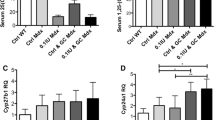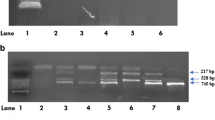Abstract
Myotonic dystrophy type 1 (DM1) is a multisystemic disorder affecting, among others, the endocrine system, with derangement of steroid hormones functions. Vitamin D is a steroid recognized for its role in calcium homeostasis. In addition, vitamin D influences muscle metabolism by genomic and non-genomic actions, including stimulation of the insulin-like-growth-factor 1 (IGF1), a major regulator of muscle trophism. To verify the presence of vitamin D deficit in DM1 and its possible consequences, serum 25-hydroxyvitamin D (25(OH)D), calcium, parathormone (PTH), and IGF1 levels were measured in 32 DM1 patients and in 32 age-matched controls. Bone mineral density (BMD) and proximal muscle strength were also measured by DXA and a handheld dynamometer, respectively. In DM1 patients, 25(OH)D levels were reduced compared to controls, and a significant decrease of IGF1 was also found. 25(OH)D levels inversely correlated with CTG expansion size, while IGF1 levels and muscle strength directly correlated with levels of 25(OH)D lower than 20 and 10 ng/ml, respectively. A significantly higher percentage of DM1 patients presented hyperparathyroidism as compared to controls. Calcium levels and BMD were comparable between the two groups. Oral administration of cholecalciferol in 11 DM1 patients with severe vitamin D deficiency induced a normal increase of circulating 25(OH)D, ruling out defects in intestinal absorption or hepatic hydroxylation. DM1 patients show a reduction of circulating 25(OH)D, which correlates with genotype and may influence IGF1 levels and proximal muscle strength. Oral supplementation with vitamin D should be considered in DM1 and might mitigate muscle weakness.




Similar content being viewed by others
References
Ørngreen MC, Arlien-Søborg P, Duno M, Hertz JM, Vissing J (2012) Endocrine function in 97 patients with myotonic dystrophy type 1. J Neurol 259:912–920
Johansson A, Andrew R, Forsberg H, Cederquist K, Walker BR, Olsson T (2001) Glucocorticoid metabolism and adrenocortical reactivity to ACTH in myotonic dystrophy. J Clin Endocrinol Metab 86:4276–4283
Antonini G, Clemenzi A, Bucci E et al (2011) Hypogonadism in DM1 and its relationship to erectile dysfunction. J Neurol 58:1247–1253
Christakos S, Ajibade DV, Dhawan P, Fechner AJ, Mady LJ (2011) Vitamin D: metabolism. Rheum Dis Clin North Am 38:1–11
Raisz LG (2005) Pathogenesis of osteoporosis: concepts, conflicts, and prospects. J Clin Invest 115:3318–3325
Ceglia L, Harris SS (2012) Vitamin D and its role in skeletal muscle. Calcif Tissue Int 92:151–162
Hamilton B (2010) Vitamin D and human skeletal muscle. Scand J Med Sci Sports 20:182–190
Soliman AT, Al Khalaf F, Alhemaidi N, Al Ali M, Al Zyoud M, Yakoot K (2008) Linear growth in relation to the circulating concentrations of insulin-like growth factor I, parathyroid hormone, and 25-hydroxy vitamin D in children with nutritional rickets before and after treatment: endocrine adaptation to vitamin D deficiency. Metabolism 57:95–102
Salehi LB, Bonifazi E, Stasio ED et al (2007) Risk prediction for clinical phenotype in myotonic dystrophy type 1: data from 2,650 patients. Genet Test 11:84–90
Terracciano C, Celi M, Lecce D, Baldi J, Rastelli E, Lena E, Massa R, Tarantino U (2013) Differential features of muscle fiber atrophy in osteoporosis and osteoarthritis. Osteoporos Int 24:1095–1100
Holick MF (2007) Vitamin D deficiency. N Engl J Med 357:266–281
Romagnoli E, Caravella P, Scarnecchia L, Martinez P, Minisola S (1999) Hypovitaminosis D in an Italian population of healthy subjects and hospitalized patients. Br J Nutr 81:133–137
Mayo Foundation For Medical Education And Research (accessed 01/07/2013) http://www.mayomedicallaboratories.com/test-catalog/print/15867
Heatwole CR, Eichinger KJ, Friedman DI et al (2011) Open-label trial of recombinant human insulin-like growth factor 1/recombinant human insulin-like growth factor binding protein 3 in myotonic dystrophy type 1. Arch Neurol 68:37–44
Bischoff-Ferrari HA (2012) Relevance of vitamin D in muscle health. Rev Endocr Metab Disord 13:71–77
Fluss J, Kern I, de Coulon G, Gonzalez E, Chehade H (2012) Vitamin D deficiency: A forgotten treatable cause of motor delay and proximal myopathy. Brain Dev Epub ahead of print pii: S0387-7604(12)00303-8
Geh JL, Moss AL (1999) Multiple pilomatrixomata and myotonic dystrophy: a familial association. Br J Plast Surg 52:143–145
Harper PS (1989) Myotonic Dystrophy, 2nd edn. Saunders, London
Lagari V, Gómez-Marín O, Levis S (2013) The role of vitamin D in improving physical performance in the elderly. J Bone Miner Res doi: 10.1002/jbmr.1949 [Epub ahead of print]
Toffanello ED, Perissinotto E, Sergi G et al (2012) Vitamin D and physical performance in elderly subjects: the Pro.V.A study. PLoS One. 7:e34950. doi: 10.1371/journal.pone.0034950 [Epub ahead of print]
Acknowledgments
This work was supported by R.S.A 2009 and ASI Grant # I/R/337/02 to RM.
Conflicts of interest
On behalf of all authors, the corresponding author states that there are no conflict of interest.
Ethical standard
This study has been approved by the appropriate ethics committee and has therefore been performed in accordance with the ethical standards laid down in the 1964 Declaration of Helsinki.
Author information
Authors and Affiliations
Corresponding author
Rights and permissions
About this article
Cite this article
Terracciano, C., Rastelli, E., Morello, M. et al. Vitamin D deficiency in myotonic dystrophy type 1. J Neurol 260, 2330–2334 (2013). https://doi.org/10.1007/s00415-013-6984-1
Received:
Revised:
Accepted:
Published:
Issue Date:
DOI: https://doi.org/10.1007/s00415-013-6984-1




